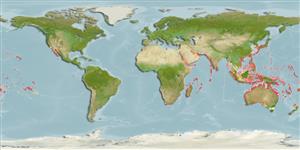Environment: milieu / climate zone / depth range / distribution range
Ecology
Marine; reef-associated; oceanodromous (Ref. 51243); depth range 2 - ? m (Ref. 35942). Tropical; 37°N - 41°S, 17°E - 109°W
Indo-Pacific: Antitropical; Red Sea, South Africa, western and eastern Australia, Lord Howe and Rapa islands, southern Japan and Ryukyu Islands. Records for countries in the tropical zone needs further confirmation.
Length at first maturity / Size / Weight / Age
Maturity: Lm 36.0, range 34 - 38 cm
Max length : 75.0 cm TL male/unsexed; (Ref. 30573); max. published weight: 1.9 kg (Ref. 40637)
Dorsal
spines
(total): 11;
Dorsal
soft rays
(total): 11-12;
Anal
spines: 3;
Anal
soft rays: 10 - 12;
Vertebrae: 16. This species is distinguished by the following characters: terminal mouth is almost in an oblique angle; presence of scales in the interorbital region; D XI,11-12 rays; A III,10-12; gill rakers externally on first arch 4-7 + 13-17; pectoral fin is relatively short, 13.6-21.3 %SL); anal-fin base relatively long (18.1-24.8 %SL; lateral line scales 61-76, with pores 51-60; longitudinal scales 54-67; cheek scales 9-16; vertebrae 10 + 16; low number of pterygiophores, dorsal 20-21 and anal 12. Colour of body variable brownish to silvery with dusky unpaired fins when fresh; soft parts of the dorsal and anal fins appear dusky and have black or darker edges; dark edges on dorsal, anal and caudal fins appear pronounced in more adult individuals, but may also vary from habitat to habitat; cheek and area below eye usually with a white or silvery streak (Ref. 95491).
Found around exposed seaward reefs of isolated high islands such as the northernmost Mariana and Bonin Is. Feeds on Sargassum and Turbinaria algae. Valued as a food fish, but not in Hawaii (Ref. 3921).
Life cycle and mating behavior
Maturity | Reproduction | Spawning | Eggs | Fecundity | Larvae
Knudsen, S.W. and K.D. Clements, 2013. Revision of the fish family Kyphosidae (Teleostei: Perciformes). Zootaxa 3751(1):001-101. (Ref. 95491)
IUCN Red List Status (Ref. 130435)
Threat to humans
Harmless
Human uses
Fisheries: commercial; gamefish: yes; aquarium: commercial
More information
ReferencesAquacultureAquaculture profileStrainsGeneticsElectrophoresesHeritabilityDiseasesProcessingNutrientsMass conversion
Tools
Special reports
Download XML
Internet sources
Estimates based on models
Preferred temperature (Ref.
123201): 24.5 - 29.2, mean 28.1 °C (based on 3109 cells).
Phylogenetic diversity index (Ref.
82804): PD
50 = 0.5000 [Uniqueness, from 0.5 = low to 2.0 = high].
Bayesian length-weight: a=0.01660 (0.00847 - 0.03251), b=2.98 (2.80 - 3.16), in cm total length, based on LWR estimates for this species & (Sub)family-body (Ref.
93245).
Trophic level (Ref.
69278): 2.0 ±0.0 se; based on diet studies.
Resilience (Ref.
120179): Low, minimum population doubling time 4.5 - 14 years (Preliminary K or Fecundity.).
Fishing Vulnerability (Ref.
59153): Moderate to high vulnerability (50 of 100).
Nutrients (Ref.
124155): Calcium = 33.2 [15.7, 62.1] mg/100g; Iron = 0.512 [0.296, 0.884] mg/100g; Protein = 18.2 [16.9, 19.5] %; Omega3 = 0.0724 [, ] g/100g; Selenium = 38.6 [18.7, 82.2] μg/100g; VitaminA = 31.9 [6.6, 137.0] μg/100g; Zinc = 1.24 [0.84, 1.86] mg/100g (wet weight);
